
MAG5035
-
Posts
5,718 -
Joined
-
Last visited
Content Type
Profiles
Blogs
Forums
American Weather
Media Demo
Store
Gallery
Posts posted by MAG5035
-
-
3 hours ago, Atomixwx said:
I think until there is a giant shakeup in the Pacific, our weather is our weather. There doesn't seem to be a lot of difference so far in the "triple dip," and if anything, at least in my neck of the nape, nape of the woods, it's been warmer and less snowy than the previous seasons.
The cold, this coming front notwithstanding, has been progged to be impressive, but mutes as it arrives and it's cold but not too cold, and sometimes it's still close to average. The warm is warm, but not torch. We're kinda just... luke.
And until the big change happens, whenever that is, not a long else will.
Sent from my motorola edge 5G UW (2021) using Tapatalk
34 minutes ago, Atomixwx said:Wind Chill Watch. I've never seen that before. Wind Chill values around -25.
Does this have to eventually be upgraded to a Wind Chill Warning?
Sent from my motorola edge 5G UW (2021) using Tapatalk
The Pac influence this month definitely played a hand in delaying/muting the arrival of cold by at least a week or so in the first half of the month in the form of some troughing in the western states (-PNA) and also a small period of +EPO which has since flipped negative. It is finally in the last few days since last Thursday’s event that we have settled into a colder regime. Originally, an actual worry of mine going into this period we had of significant -NAO/AO was watching something big go south/east of us and snow on the Mid-Atlantic. If we would’ve had a more traditional big western ridge, that reality might have happened, or perhaps something in between. Teleconnections are just indexes, and the positioning of the features that drive whether those indexes are positive/negative/etc are not always completely ideal for what we want. Case in point with this coming system.. western ridge is positioned just a bit too far west.
Now speaking about this particular cold shot, I agree in terms of longevity. The EPO is in the process of flipping back to positive over Christmas weekend, and appears to remain pretty positive next week and perhaps beyond for a time. That will shut off the arctic air source region and allow our weather to rapidly modify back to at least average temps. In the meantime however.. from about Friday night-Sunday night, this is going to be a major shot of cold and one of the coldest Christmas holidays in years.
The combo of the temp and the winds behind this really deep low pressure are going to make for some dangerous wind chills. Pretty much all models are supportive of wind chill warning type apparent temps in the Laurels and north central mountains. The rest of CTP’s area will likely end up with wind chill advisories. The other thing about this system is since the deep low tracks through and north of the Lakes, the westerly flow pulls the arctic air directly from the North-Central under the lakes through the Ohio Valley to us. A NW flow over the unfrozen lakes would have modified the air some. The drawback there of course is that there won’t be much in the way of LES in the western parts of CTP as the W/WSW flow will target W NY and far NW PA once again for significant lake snows.
-
 2
2
-
-
1 hour ago, Bubbler86 said:
We do not get much CAD here either (I am on the other side of the ridges from the LSV), but we had pretty extensive Ice and lots of tree damage just a few hundred feet above me (up the mountain). I am not that familiar with the layout of the Laurels as to who might have received ice. I know Mag had quite a bit. So just wind damage, wow. We never had that much wind here....not damage level at least.
Sleet was the dominant precip type here on this side of the Laurel’s from that event. I had a fresh 0.7” of snow early Sunday morning from some upslope but otherwise all this on the ground is hard pack pingers. I guess that’s one way to ensure a white Christmas.
-
 4
4
-
-
Models are narrowing the corridor for potential frozen on the front end, keeping it in the interior counties for the most part. Still a chance for the LSV to see some mixed depending on timing (faster) but it does appear that the best chance of anything accumulating stays west of the Sus river and likely closer to the I-99 corridor. Way too early look at the NAM…which has most of the front end phase in it’s range now is unimpressed thermally, with maybe a little bit of ice but not much in the way of any frozen anywhere. Will have to see how that evolves, one thing that occurred in the last event noted by CTP during the storm was models were a couple degrees too cold aloft, delaying the changover to snow that was supposed to occur for that. Different situation here, but a detail like that is something that could be the difference between a few inches of snow vs some mix and icing where models have been showing the corridor of snow.
Either way, all of C-PA warms and any mix turns to rain ahead of the approaching rapidly deepening low and associated frontal boundary. It looks like the Sus Valley touches the 50s Thurs night into Fri morning with the rest of central and northern generally in the high 30s-low 40s. Frontal passage timing about late morning west to the mid-later afternoon east on Friday.
Snow behind the front is still a big question mark of course. We’re probably going to have to wait for 3k NAM and HRRR time to really get a handle on that. Euro is really not printing much snow accums at all despite looking okay on the conditional maps. GFS puts out a couple inches of snow in the Sus Valley. Since this has really turned into straight up lakes cutter event with no secondary coastal influence, I do kind of worry about the downslope component drying out the precip behind the front, especially the in the southern parts of the Sus Valley. Plus the GFS has seemed to have a knack for being overzealous on digital LSV snow as of late. I don’t have any problem seeing those types of accums in the western half of PA or the Laurels but it’s a big question mark from the ridge and valley part of PA eastward. I will say this, considering the very rapid temp drops behind the front and gusty winds, ANY kind of snowfall be it a dusting or whatever could quickly create hazardous conditions. And being this occurs on Friday afternoon/evening of Dec 23rd, I think travelers probably should be mindful of that.
Lastly I think most of the area probably see winds of the advisory variety with and behind the front (and perhaps some breezy weather in the Sus Valley beforehand). Outside of potentially the Laurels, I don’t think we’ll see any prolific high wind warning type winds that one would think you’d see with a deep storm of this nature. Reason being is i think the more western track of the low may take the best pressure rises through Ohio, western PA and western NY. It will still be quite windy either way with low wind chills, especially Fri Night and Christmas Eve.
-
 1
1
-
 7
7
-
-
Overnight model runs had actually bumped east some in the case of the GFS and Canadian, both having Apps runner solutions right through PA. Euro maintained its deep low to the Lakes and new 6z GFS has went back that way as well. An Apps runner doesn’t really suit us much better and in fact would probably slot us from anything related to the frontal passage/back end (esp LSV). What everything does have at this point is snow/mixed associated with the initial wave that develops on Thursday. This feature will have high support via 1035-1040ish high in Quebec, which will be retreating but would likely be enough for a period of accumulating snow/ice over a good portion of C-PA. Interior counties would be favored, but most or all of the LSV could get it too.
The Euro continues to be the best looking model with the anafrontal feature associated with the frontal passage. I get that those scenarios are a hard thing to turn to real snow on the ground, especially in the LSV but this is one of those scenarios that should deliver at least a couple hours of snowfall behind the front. Modeled temps in H-burg (via Euro) go from 41 at 15z Friday to 26ºF at 18z and well into the teens by dark. The cold isn’t going to be screwing around. So I think there’s a decent chance of picking up an inch or two at least. Then there’s the whole flash freeze part of that as well. Still lots to sort out with that system as a whole. Can this main shortwave still end back up getting to the coast or coastal plain below our latitude? I doubt it at this point but not going to completely rule that out. Right now this looks like a pretty significant snowstorm for the Ohio Valley folks.
Didn’t have time yesterday but wanted to touch on the pattern after this major weather system gets through. Christmas is going to be very cold for sure, and it will remain fairly cold for at least the first half of the following week between Christmas and New Years. Unfortunately, I see the pattern moderating for us and well a big portion of the CONUS before New Years. We neutralize but don’t lose the -NAO/AO but models all prog a major swing of the notably -EPO at present to an equally notable positive EPO by Christmas and especially later that week. Models have also been showing signs of moving the MJO through 4-5-6 during that week (likely not a coincidence with regards to the EPO going +). Given the NAO/AO still staying somewhat negative and the PNA actually being positive, we might keep a mean trough over the eastern US but the +EPO changes the source region of air to a more Pacific origin. So we might not torch…but it’s definitely going to warm up. I think the good thing about this is it appears that we could set up the MJO to be in favorable phases getting into January and as long as any pattern doesn’t bog down in 4-5-6, we’ll have chances.
-
 3
3
-
 2
2
-
-
Well something had to give with this, during the 0z suite last night we had the GFS low in Cape Hatteras while the Euro/CMC had it in Michigan. Of course the GFS joins the party today cutting what looks like is going to be quite a strong storm. As was mentioned, western ridge axis is being progged too far west to allow for the coastal solution.
Barring any wholesale changes back the other way, I see two opportunities for frozen with this whole thing. Up front, where the GFS/Euro have been developing this wave on the coast in front of the main vigorous shortwave that becomes the big storm bringing precip into C-PA. This looked more like the Thur/Thur night timeframe. There will be decent high pressure (retreating) to the N and NE so anything associated with that may start as frozen, especially interior counties. Unfortunately with how things are being progged now with all 3 major models (with ensemble support), the vigorous shortwave digs and head towards the Lakes, which will draw up warmer air for a brief time (likely for about 12 hrs or so) sometime from Thur night into Friday. The second opportunity comes after the frontal passage, which looks like an anafrontal type scenario… something that could deliver snowfall for several hours behind the front. The cold air associated with this system will mean business and there looks to be rapid temp drops behind the front. Whatever gets on the ground from that will definitely be there come Christmas morning.
-
 1
1
-
-
As far as event totals, I had about 1.7” of total frozen…basically 1.6” of sleet and a skiff of wet snow on top. Ice accums were negligible after it touched above freezing with surface temps but I think I had roughly a tenth of so of that this morning.
The lull in the precip this afternoon definitely affected the overall outcome by coming to this area at a time when precip was getting ready to turn to snow and/or reach prolific pinger event status. The secondary batch mostly went just east of here. The result is a bit of a bust, but that much sleet is still a good bit to deal with. And it will have staying power with a cool forecast from here on til whatever happens near Christmas
-
 1
1
-
-
We have flipped to snow here, steady temp at 33°.
-
 4
4
-
-
In a lull in the precip currently, hopefully can get some regen of the precip shield back this way this afternoon. Something the HRRR continues to advertise later this afternoon (after about 19-20z) showing a renewed surge of precip (which should be mostly snow with the cooling aloft) into the central counties likely associated with the deepening of the coastal low. That’s going to play big on what the eventual snow totals end up being in the AOO-UNV-IPT corridor. CTP had already backed off some on totals due to models starting a couple degrees too cold with this initial phase of the precip shield.
What’s also likely to happen as the low tracks across the Chesapeake into the Delmarva this afternoon/eve is that will eventually push the R/S line near or more likely above Harrisburg in the Sus Valley, so the next few hours is likely the time to put something on the ground for the LSV’ers that are seeing frozen precip.
-
Still pinging away here, my temp has actually creeped up to 32.7ºF. There’s over 1.5” of all sleet on the ground. Good to see some of you guys starting to see the snow changeover.
-
 1
1
-
-
Wake up obs, moderate sleet/ZR combo and 30ºF currently. Already a coating of sleet on all surfaces to go with a glaze. Gonna be quite the high impact event here today, especially if the timely transition to snow occurs and delivers the several inches.
-
 2
2
-
-
26ºF currently, up from being as low as 25ºF about an hour ago.
-
Model evolution since my last posting on Saturday has generally trended toward a more progressive secondary coastal low. And when I say “progressive” I mean it keeps on tracking into New England and beyond vs a stall and capture situation. That of course would take the Dec ‘92 2+day storm scenario off the table.
What we seem to be looking at with this is a primary wave of warm advection precip that progresses into the region on Thursday, that perhaps enhances as we get development on the coast. Since this keeps moving, we’re going to be on more of a time crunch to get the column right for all snow. Basically, this is the scenario mentioned last week with the far west cutting primary hitting the blocking and forcing secondary development. We will have CAD and the actual secondary low on the coast (which wasn’t being modeled much at all at that point), so think most of the subforum sees a mix event up front, transitioning to snow in the interior counties as the coastal low gets going. Further south LSV (LNS/THV) is going to be dependent on coastal track as the low lifts up (could transition to rain if it’s too close) while upper LSV places like Harrisburg eventually transition to a period of snow. CTP mentioned in their AFD about dynamic and evaporative cooling of the column as well, which could imply a situation where the initial precip shield ends up being a thump of snow after brief early mixing.
To put all of this simply, it’s going to be difficult to resolve p-type issues for awhile yet… per usual.
-
 1
1
-
 3
3
-
-
1 hour ago, Newman said:
Having serious thoughts of "chasing" this storm out there in central PA, lots of similarities to Dec 1992. Anybody know of any good State Parks I could rent a cabin at in that general area of Blair and Clearfield counties?
All usual disclaimers aside on details, I agree on the Dec ‘92 similarities. We have the setup to deliver that kind of event. I said this 10 days ago on page 1 of this thread.
QuoteSo big question to me is storm track. The strong Greenland block would certainly suppress it, but getting completely overwhelmed with arctic air probably doesn’t help us either in the snow department. Being somewhere in between would be ideal of course. The -PNA is generally forecast to slowly neutralize but stay negative, which in this instance may be a good thing of keeping us in a more active gradient zone. There’d be great potential for something big if we were to line up a coastal with eastern CONUS cold in place and a -NAO induced suppressed (and blocked) storm track coupled with a very warm NW Atlantic SST wise.
So we have an assortment of possibilities on the table with this, including the Euro’s KO to the interior part of C-PA. I originally thought with the initial primary low cutting way west that if would be more of a front running frozen event (if there was enough cold/CAD) but models including the GFS now are really seeing this full on coastal development. Temps are def a bit of a concern for me, and if we get this Euro type stall/capture one will have to consider the easterly fetch.. which would surely be a highly anomalous type setup in that department. A very good thing for more interior/higher elevation places, but perhaps too much of a good thing nearer to the coastal plain (WAA aloft). Sus Valley would be a tough call with that scenario. Dec ‘92 was a highly marginal storm temp wise, Harrisburg went to rain after about 6” of snow if I remember my details right and State College still had 18” even after turning to rain in the middle of the event.. Jeff Morrow and the TWC crew drove the turnpike from Harrisburg to report at Breezewood (which had over 2ft). This may have a bit better of a CAD setup than that, but we still aren’t really incorporating truly cold air into the pattern on our side of the country yet. Still though, could be enough.
To add to the suggestions I would maybe check Blue Knob State Park, not sure what they have for winter cabin rentals though. If the euro scenario came to fruition you would be ground zero there on a mountain that’s second highest to Mt Davis. Parker Dam is a good spot though. I’d watch to see how things go for a couple more days of course. The current broad model/ensemble consensus on a bigger event has my attention, but this still has a high possibility of being a more minor or mix-ier event.
-
 6
6
-
 1
1
-
-
1 hour ago, Itstrainingtime said:
He certainly didn't seem overly excited about what he was seeing in the pattern. He acknowledged that there were a couple of things working for us, but he's also been adamant that there are issues to be resolved as well. For example, late December 2021 featured a strong -NAO and Lanco finished up at +8 for a temp departure:
"For anyone thinking that Greenland blocking (a -NAO) guarantees snow and cold for the mid-Atlantic States, you need only look back to last #December. The NAO was - for the last two weeks of the month, but temps were still 8°F above normal for the month at @millersvilleu..
The combination of a deep trough over western North America & ridging over the Southeast "offset" the -NAO & caused there to be very little snow and cold in southeastern PA. Although #December2022 should be chillier, we MAY see a modified version of this pattern."
It's only 12/6 so a lot can and probably will change, but the overall tone/demeanor has gotten notably more somber over the past several days.
The funny thing is I was just looking at last year’s winter thread and we were talking about some of the same things we are now. A positive from this is that I don’t think we’ll see the western troughing to the degree we did last December and we’re working with a stronger -NAO. Recall the western pattern in December last year was such that it delivered a season’s worth of snowfall to the Sierras in California during a few weeks of December. (Before reversing the rest of the season). There was a lot of MJO influence last December as well (P6-7), while we’re in the circle with that right now.
-
 4
4
-
-
I’ve been trying to not get too high or low on modeling and the advertised pattern as we’ve gotten into the opening week of December. Two things i mentioned up front in my last post that opened up the winter thread was the -PNA and also the model mayhem trying to handle the blocky pattern. PNA seems to get lost at times when folks discuss the Pac and the other teleconnections of that realm (the EPO and WPO), so I’m glad to see it mentioned here.
A week ago, I figured the PNA would offer resistance but ultimately a -NAO block of the caliber being presented would set us up favorably in what appears to be an active period for storms the next couple weeks.. and that modelling would eventually respond to more cold pressing. I’m sure most are aware of the whiplash of model solutions that have been shown in the last week or so. Looking at things currently, I certainly don’t think things are cooked by any means but I do think what we’re looking for will still come in a delayed fashion. To go along with the continued -PNA, the EPO is now forecast by guidance to go positive the next few to several days along with a WPO that had already been positive. After that EPO trends negative and PNA neutralizes on the progs. As long as that actually occurs, the pattern we’re looking for should come to us as the dominant -NAO/AO looks to stay established for awhile.
In the meantime, we do have systems on the table that could end up delivering wintry precip. The nearer term Fri/Sat system seems to be the best bet. The NAO block will still be doing its thing and there is a strong surface high being progged up top. Even the GFS today put some snow in PA with that system. This should deliver something to at least the interior PA counties, with the issue being QPF. There’s no amp in the pattern, and this system will weaken as it attacks the block. Still though, this could be a 1-3” or so type event somewhere in our region before it fizzles.
The system being progged around the mid-week timeframe next week looks to be a much stronger system and possibly the one that facilitates our awaited switch to the colder, more favorable regime. This one will likely cut or try to cut into the block. This could present an interesting situation that I’ve actually seen on some model solutions. With the strong blocking, it’s the kind of setup that could take the primary way west but still provide a period of wintry precip and/or snow if there’s even some marginal high support and lingering cold air. What then happens is the primary hits the block, occludes and forces a secondary somewhere on the coast. Will be something to watch… I still don’t think modelling has this pattern and specifically the -NAO blocking handled very well once to the mid-range.
-
 2
2
-
 1
1
-
-
Just finished and posted this in the old thread before I saw the winter one was made, haha.
Speaking specifically about our region (C-PA), a suppressed storm track would be a bigger concern to me than a cutting one with the establishment of a -NAO regime of the caliber thats been advertised solidly on the guidance (-3 to -4). Now truth be told, this is a great looking winter pattern upcoming for the eastern US once it does get truly established… which seems to be still in the realm of just beyond D7-10.
So big question to me is storm track. The strong Greenland block would certainly suppress it, but getting completely overwhelmed with arctic air probably doesn’t help us either in the snow department. Being somewhere in between would be ideal of course. The -PNA is generally forecast to slowly neutralize but stay negative, which in this instance may be a good thing of keeping us in a more active gradient zone. There’d be great potential for something big if we were to line up a coastal with eastern CONUS cold in place and a -NAO induced suppressed (and blocked) storm track coupled with a very warm NW Atlantic SST wise.
What also comes with a blocky pattern? Model mayhem trying to handle the individual features so I’d be looking for a lot of that as well
-
 3
3
-
 2
2
-
-
3 hours ago, Bubbler86 said:
The whole run is drastically different out in the upper 200's as both you and I joked about happening:-). From a blocked cutter to a southern slider. At 12Z the PA weather 540 line was in PA on Dec 11th...at 18z it is in Central Alabama. How much for Cape Hatteras?
Speaking specifically about our region (C-PA), a suppressed storm track would be a bigger concern to me than a cutting one with the establishment of a -NAO regime of the caliber thats been advertised solidly on the guidance (-3 to -4). Now truth be told, this is a great looking winter pattern upcoming for the eastern US once it does get truly established… which seems to be still in the realm of just beyond D7-10.
So big question to me is storm track. The strong Greenland block would certainly suppress it, but getting completely overwhelmed with arctic air probably doesn’t help us either in the snow department. Being somewhere in between would be ideal of course. The -PNA is generally forecast to slowly neutralize but stay negative, which in this instance may be a good thing of keeping us in a more active gradient zone. There’d be great potential for something big if we were to line up a coastal with eastern CONUS cold in place and a -NAO induced suppressed (and blocked) storm track coupled with a very warm NW Atlantic SST wise.
What also comes with a blocky pattern? Model mayhem trying to handle the individual features so I’d be looking for a lot of that as well.
-
 1
1
-
 2
2
-
-
It took awhile to find the time it was logged but apparently my WS-5000 logged a 60.2 mph daily max wind gust at 3:46 this afternoon. There were some decent gusts at that time of the day but not sure about that high of one. I have notifications set to alert for gusts >50mph and that gust was the only one to trigger that today. I suppose it’s possible.
-
3 minutes ago, Bubbler86 said:
You going with T or .01? :-)
Definitely a T lol, with 2-4” drifts out of the water spouts.
Pretty unique as far as thunderstorms go. Wasn’t much wind that mixed down as we’re locked in with cool air damming. It’s finally cracked 40° after being in the high 30s all day.
-
 1
1
-
-
-
-
The big issue I see getting into the opening week of December or so is despite the good teleconnection progs in the NAO/AO/EPO realm, the development of a pretty negative PNA in the interim is going to drive up the SE ridging. I think the evolution to this was probably a factor in losing the chance of our weekend system being anything wintry, that and the complete loss of a high pressure to the north that was a key factor in the wintry solutions several days ago.
In contrast to last December, which also had a really negative PNA (much more negative at one point than what is currently being forecasted on model progs), we have the other teleconnections looking half decent going forward. We also have MJO influence that is currently in Phase 6, that should progress into colder phases (for NDJ) 7 and perhaps 8 eventually. I think we’ll get to where we need to for a good period of potential winter mischief, but it probably comes at some point during or more likely… after the first week of December.
-
 1
1
-
 4
4
-
-
-
Forgot to post this pic from going hunting yesterday morning. This is from Rothrock State Forest in NW Huntingdon Co.
The snow shrunk a good bit of course, but there is still a majority of the ground that has a pack today here. Also received an inch of new snow in the early morning hours today from the LES/upslope.
-
 7
7
-

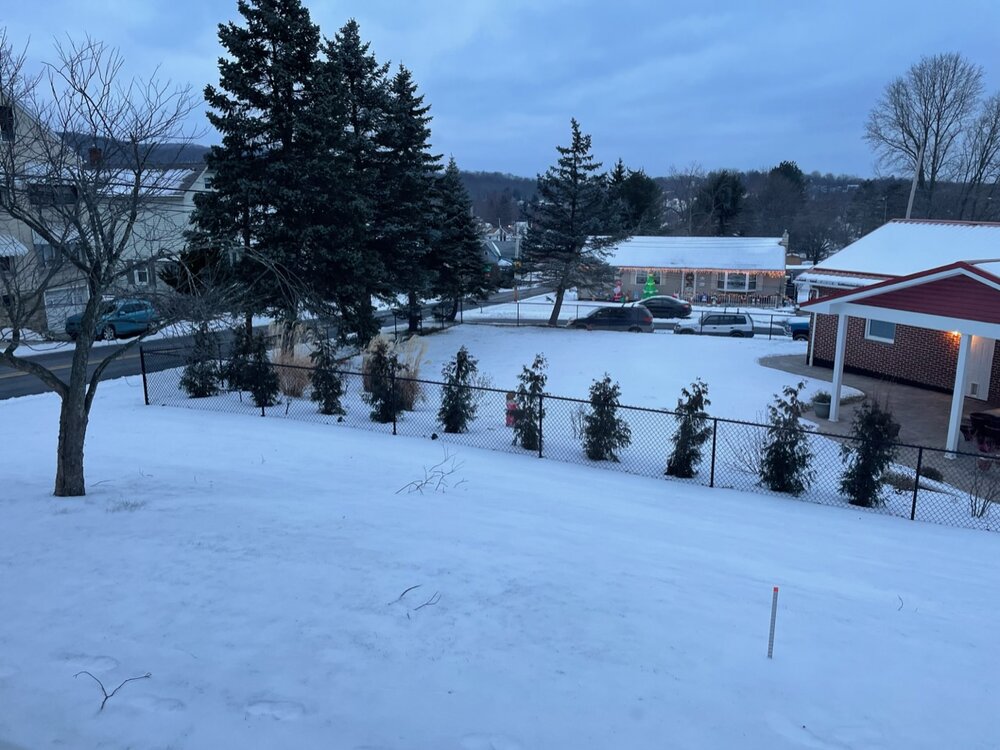
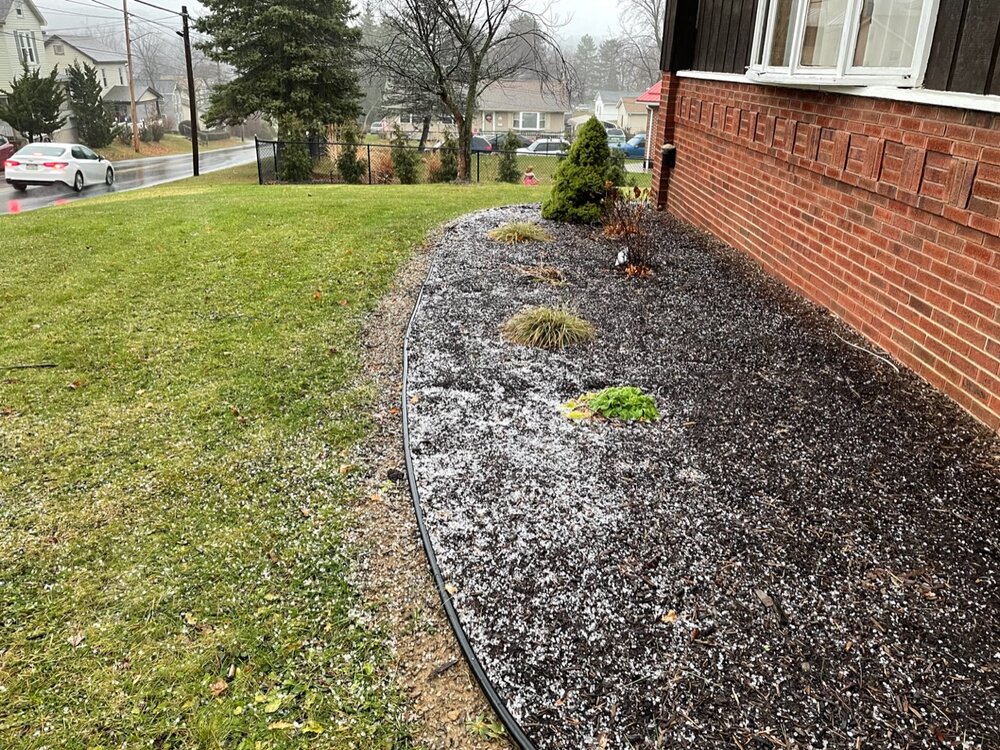
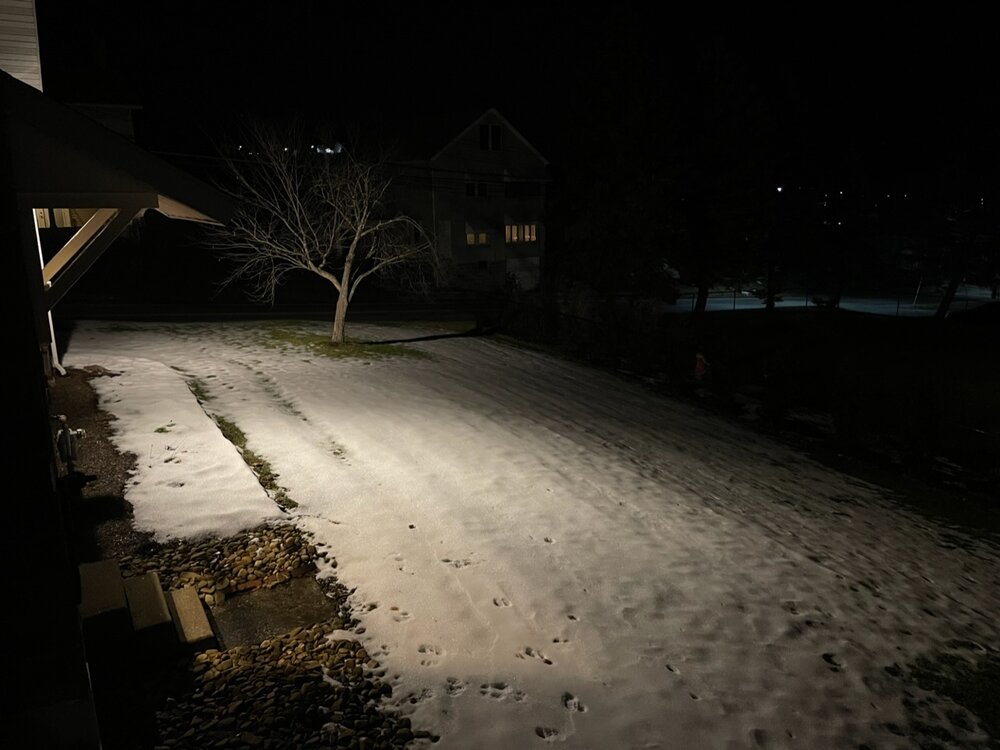
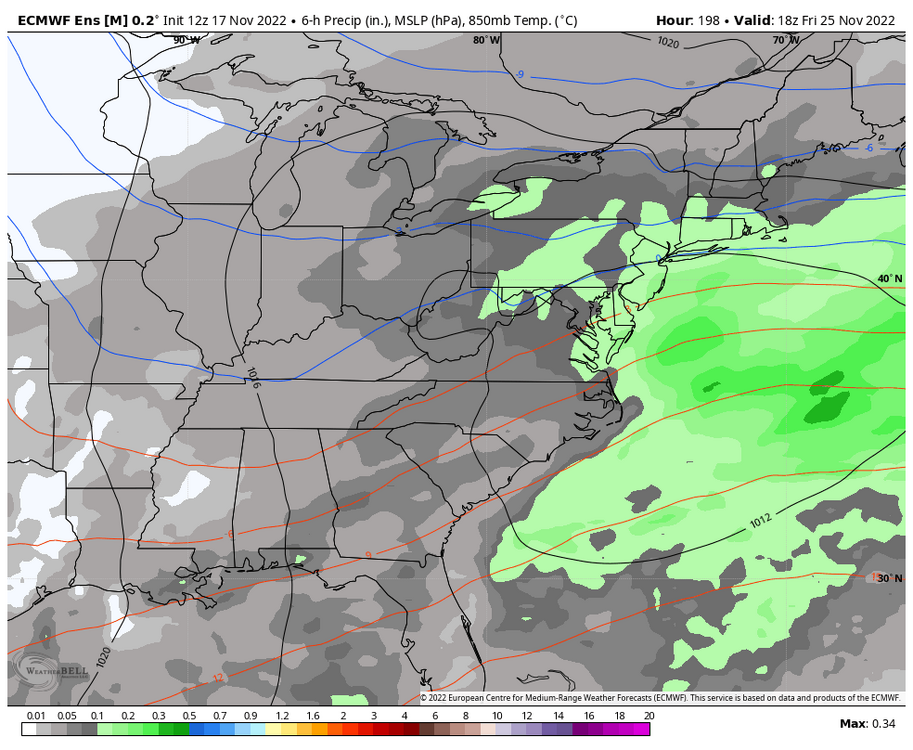
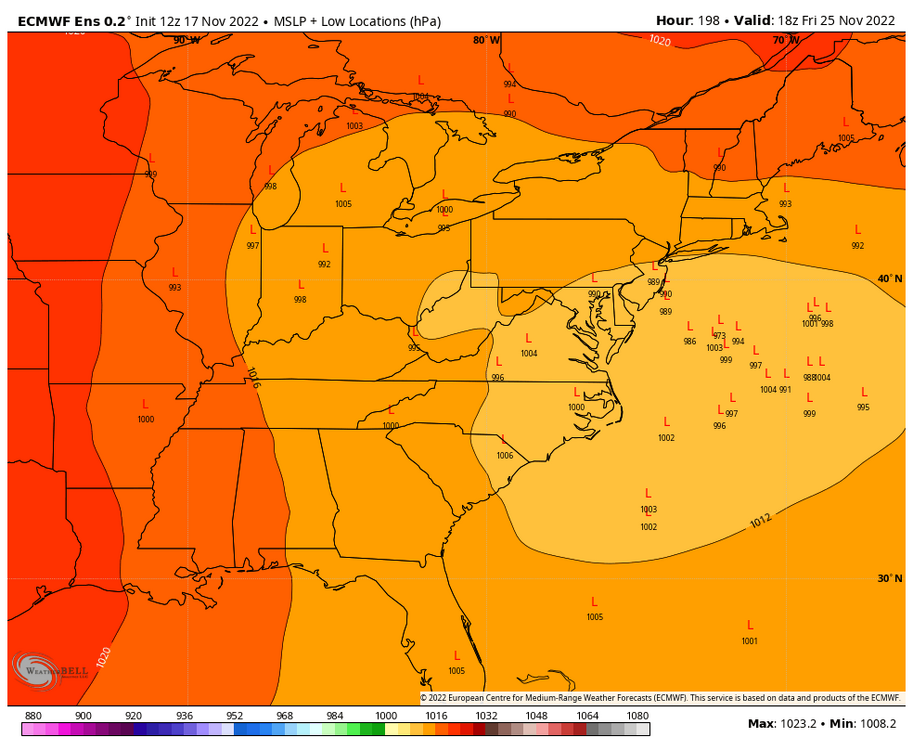
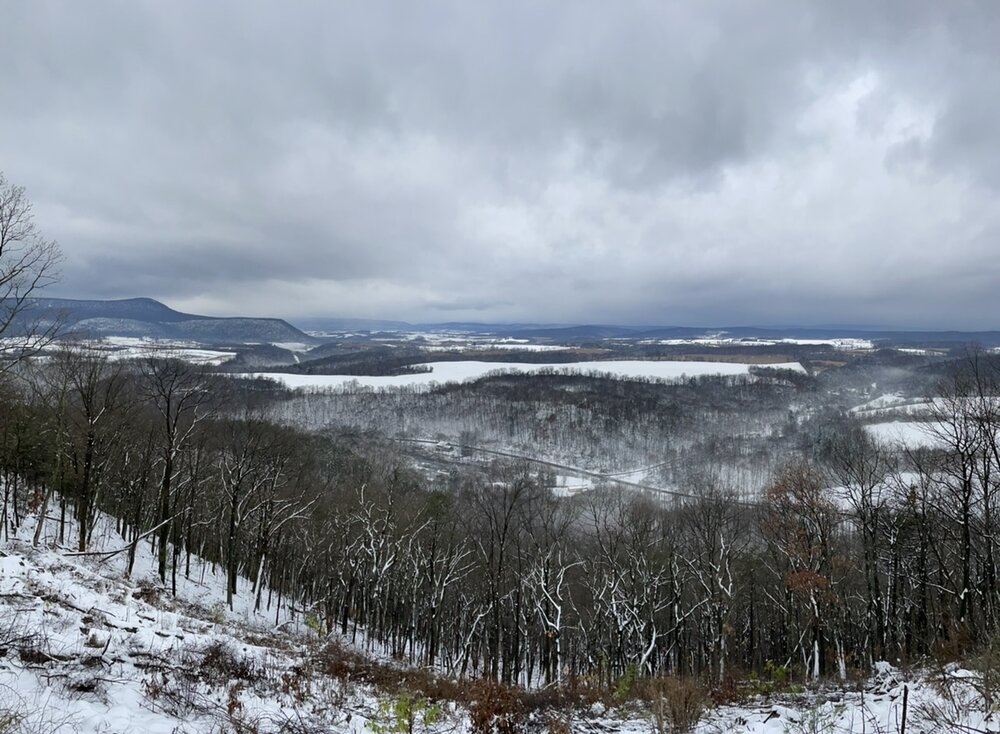
Central PA Winter 2022/2023
in Upstate New York/Pennsylvania
Posted
Hard to argue with a pretty decent model consensus getting notable accumulating snow pretty far into the Sus Valley, although I’ve been working on trying to be more cautious with these type of situations there this season after learning the hard way the last couple seasons. I’m still leery southeast of I-81. Comparison of the high res short range guidance shows some differences. HRRR has a much colder column, allowing the widespread snowfall as far into the Sus Valley as it goes. The 3k NAM (not the coarser 12k NAM) definitely isn’t as enthused, and looks pretty close to what CTP has out for a snowmap right now, not showing much at all in the LSV . That particular model erodes 850mb much faster in the Sus Valley and keeps most accumulating snow even out of Harrisburg. Adding to that, here’s what the 0z run of SPC’s HREF has, which looks similar to the 3k NAM.
So just keeping things in perspective a bit, showing there are some high res short range things that don’t show the explosion of snow in the Sus Valley. I tend to think reality lies somewhere in between, as there should be enough cold to start things as snow in a good portion of the Sus Valley especially if precip gets here in a timely fashion and there are good rates. Top end accums are another thing to get sorted out. A lot of the short range and global guidance have no problem getting high end advisory amounts, with some full blown WSW type amounts in the interior south central counties. Still trying to figure whether I would want to pull the trigger on believing that or not. I do think the current advisory counties should be bumped up from their 1-3” to at least 2-4” with some scattered 5”.. and perhaps getting the 1” line to I-83 with Harrisburg maybe 1-2”. That would be my “safe” call with this. My worry is the HRRR is too cold.. and some of the short range stuff was a couple degrees too cold with the last event. I’m also not completely ruling out the colder, snowier HRRR type solution either.